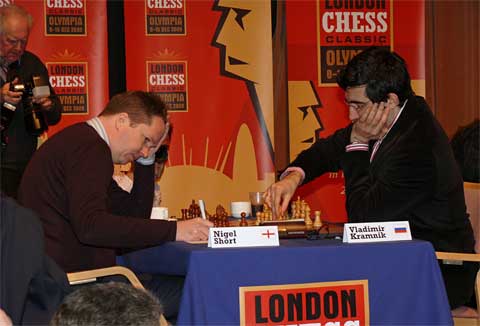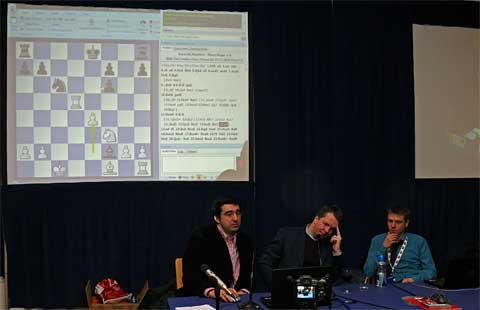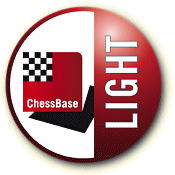
Round six report
By John Saunders
| Round
6: Monday, December 14, 2009 |
| Vladimir Kramnik |
1-0 |
Nigel Short |
| Magnus Carlsen |
½-½ |
Michael Adams |
| Luke McShane |
0-1 |
Ni Hua |
| David Howell |
½-½ |
Hikaru Nakamura |
|
The penultimate round was full of exciting chess. It featured two decisive
games and the number should arguably have been three had things gone Michael
Adams’ way. Vladimir Kramnik’s win against Nigel Short took him
within one point of Magnus Carlsen which means that these two cannot be caught
by anyone else but either of them could still win the tournament.

Magnus Carlsen vs Mickey Adams in round six
Magnus Carlsen had a narrow escape when he played a strange opening and overreached
against Michael Adams. The English super-grandmaster sacrificed a piece for
a dangerous counter-offensive. For some time it seemed as if Carlsen would lose
and endanger his chances of appearing at the top of the January 2010 FIDE Rating
List (he needs at least two draws or one win from the last two games to be sure
of this). But Michael hesitated, repeated the position a couple of times and
ultimately missed a chance of finishing the game quickly. He still emerged with
a strong position but Carlsen managed to hold the draw, ensuring that he would
stay top of the table going into the last round.
Carlsen,Magnus (2801) - Adams,Michael (2698) [E46]
London Chess Classic London (6), 14.12.2009 [John Saunders]
1.d4 Nf6 2.c4 e6 3.Nc3 Bb4 4.e3 0-0 5.Nge2 d5 6.cxd5 exd5 7.g3 Re8 8.Bg2
Bf8. It seems to have been a recurring theme in this tournament: bishops
going home to their original squares. Perhaps we could dub it a 'London bishop'?
9.0-0 Na6 10.a3 c6 11.f3 c5 12.g4 h6 13.h3
About 20 years ago, I adopted a similar structure of pawns around a fianchettoed
bishop in my play and my clubmates thereafter referred to such a configuration
as 'a Saunders bishop'. I should add that they did not mean it in a nice way:
it was a cruel jibe intended to undermine what little faith I had in my strategic
abilities. I just hope some of these unkind people are reading this annotation
and can see that the Saunders bishop now comes with the Carlsen stamp of approval.
In fact, by way of a Christmas present, I am prepared to cede any claim I have
to naming rights for this to him – completely free, gratis and for nothing.
But I am not sure he would want it because his position isn't terribly good
here. Black has much the easier position to play. 13...b6 14.Ng3 Bb7 15.f4
Rc8 16.g5. Carlsen probably felt morally obliged to justify the overextension
of his kingside but this does not help. 16...hxg5 17.fxg5 Ne4! Black
has quite an audacious plan in mind. 18.Ncxe4 dxe4 19.Qg4 g6 20.Nxe4 Bxe4
21.Bxe4 cxd4! 22.Bb7 Rc2! 23.Bxa6 Qc7
Black has given up a piece for a strong attack. 24.Qf4 Bd6 25.Qf3 Bc5.
Here the commentary and press rooms were willing Black to play 25...dxe3! The
reason Michael Adams didn't play this was because he thought White could play
26.Bd3, missing the fact that Black could then follow up with 26...Bc5! which
should sure the win for Black after 27.Bxc2 e2+ 28.Kg2 exf1Q+ 29.Qxf1 Qc6+!
etc. Easily missed, of course. I think Carlsen also missed the Bc5 possibility.
26.Qf4 Bd6. One intriguing line considered in the commentary room was
26...Re5 27.exd4?! Rxg5+! 28.Kh1 Qc6+ 29.Qf3 and now the bone-crushing move
29...Rg3!! 30.Qxc6 Rxh3+ 31.Kg1 Bxd4+ 32.Rf2 Bxf2+ 33.Kf1 Rxc6 34.Kxf2 Rh1 and
Black wins. White should play 27 e4! though it is still very complex. 27.Qf3
Bc5 28.Qf4 Qxf4. 28...Bd6 would not be a threefold repetition. 29.Rxf4
dxe3 30.Kf1. Adams admitted he had not seen the plan of Kf1-e1 for white.
30...e2+ 31.Ke1 Rd8 32.Bxe2 Re8 33.Bd2! White can't save a piece but
he can ensure that he loses the right bishop so that opposite-coloured bishops
remain on the board, thereby improving his drawing chances. 33...Rxd2 34.Kxd2
Be3+ 35.Kc2 Bxf4 36.Bc4 Bxg5 37.Rg1 Re5 38.h4. 38.Rf1 is even simpler and
would probably lead to a very early ceasefire. 38...Bxh4 39.Rxg6+ Kf8 40.Rd6
Black has an extra pawn but no real way of exploiting the material advantage.
40...Re7 41.Bb5 Rc7+ 42.Rc6 Re7 43.Rd6 Re5 44.Bc4 Rf5 45.b4 Ke7 46.Rd5 Rf2+
47.Rd2 Rf4 48.Bb5 Ke6 49.Re2+ Kf6 50.Rd2 Ke6 51.Re2+ Kf6 52.Rd2 Bf2 53.Rd7 a5
54.bxa5 bxa5 55.a4 Bc5 56.Rd5 Bb4 57.Kd3 Ke6 58.Rd4 Rf3+ 59.Ke2 Ra3 60.Bc4+
Ke5 61.Rd3 Rxd3 1/2-1/2. [Click
to replay]

After the game the players come to the commentary room for a breathtaking
session

Magnus and Mickey analysing for the local and the world-wide Playchess audience.
Everything is saved and will be made available to the general public in the
future.
Vladimir Kramnik moved up to within one point of Carlsen and consigned Nigel
Short to last position after a scrappy game. The fans were impressed by the
fighting spirit, and probably the entertaining commentary (Kramnik and Short
in action together was riveting) and it was voted best game of the day. The
Russian unfurled a new move, 8 Bg5, against Short’s Nimzo-Indian set-up
and the English number one struggled against his well-prepared opponent. Kramnik
soon won a pawn and, despite a possible chance for Short to get back into the
game with 25…Qxa2, Kramnik made no mistakes. Well, except in the commentary
room, much as Magnus Carlsen had in a previous round. But this time the super-GM’s
momentary lapse was seized upon by a sharp-eyed commentator who, to the undisguised
glee of the audience, demonstrated that the ex-world champion’s “winning”
idea would have resulted in him being mated on the back rank. Don’t miss
their dialogue in the annotation below...

Vladimir tells a young school chess participant which first move he is going
to play

The boy gets it right: 1.Nf3!

The start of a very tough game for Nigel Short, who later revealed to the audience...

... that his opponent had "seen absolutely everything".
Kramnik,Vladimir (2772) - Short,Nigel (2707) [D38]
London Chess Classic London (6), 14.12.2009 [John Saunders]
1.Nf3 d5 2.d4 Nf6 3.c4 e6 4.Nc3 Bb4. This opening can't quite make
up its mind whether it is the Ragozin variation of the Queen's Gambit Declined
or a line of the Nimzo-Indian. But, as William Shakespeare said, what's in a
name? 5.Qb3 c5. 5...Ba5 is an idea here. 6.cxd5 exd5 7.dxc5 Nc6 8.Bg5!?
You won't find that move on your database - it is fresh from 'Laboratoire
Kramnik'. Why did he inflict it on Short? Because he's worth it... 8.e3 0-0
9.Be2 Be6 10.Nd4 Bxc5 11.Nxe6 fxe6 12.0-0 Qe7 which was Karpov-Kramnik, Monte
Carlo 1997. Kramnik won that game. 8...Be6 9.0-0-0. Things are already
a bit tricky for Black. He decides to sacrifice a pawn. 9...Qa5 10.Bxf6 gxf6
11.Nxd5 0-0-0 12.e4 f5 13.Bc4 Bxc5. 13...Qxc5 is a bold try but 14.Kb1
fxe4 15.Ng5 looks very useful for White. 14.Ng5 fxe4 15.Nxe4 Bd4 16.Ndc3
Rhe8 17.Bxe6+ Rxe6 18.f3 Ne5. Perhaps 18...Kb8 is called for, though White
is still better. 19.Nb5
Kramnik was heard to say in the commentary room, and at a later video interview,
that his position was very strong after this. 19...Rb6. If Black backs
off with 19...Bb6 then 20.Rxd8+ Kxd8 21.Nbd6 starts to get very unpleasant.
20.Qc2+ Rc6 21.Nec3 Bxc3. The only other move worth contemplating is
21...Be3+ 22.Kb1 Kb8 23.Rxd8+ Qxd8 24.Rd1 Qg8 but really Black is a pawn down
for no compensation after this. 22.Rxd8+ Kxd8 23.Nxc3 Kc7 24.Rd1 a6 25.Qxh7
25...Kb8. It is surprising that neither player gave much thought to
25...Qxa2 here, as it is perfectly logical and apparently quite playable. When
the players were discussing this in the commentary room, they looked at 26.Qh8
Rxc3+!? 27.bxc3 Qa1+ 28.Kd2 Qb2+ 29.Ke1 Qxc3+ 30.Kf1 Qc4+ 31.Kg1 Qc5+ 32.Kh1
Analysis diagram
etc, etc, and Kramnik concluded he was winning, so they moved onto another
position. But it was suddenly apparent to the spectators that IM Lawrence Trent
was desperately straining to say something. On and on went Kramnik, barely pausing
for breath and oblivious to Lawrence's attempts to catch his eye. Eventually
the Kramnik stream of consciousness abated for a second and Lawrence seized
his chance: "Can we go back to the earlier position?" (the one in
the diagram). Then Lawrence dropped his bombshell: "Black plays 32...Nd3!!
"... the super-GMs were temporarily bemused by the sheer effrontery of
the young English commentator... Kramnik tried to rescue his line... "I
play 33.Rf1 ", but Lawrence was ready for him: "... then 33...Nf2+!!
"... another super-grandmaster pause. Kramnik, finally recognising a choice
between being mated on the back rank or being caught by Philidor's legacy, smiled
in that closed-eye way of his and said: "Well... I wouldn't have played
26 Qh8!", to a gale of mirth from an audience which was thoroughly enjoying
young Trent's moment of triumph over his elders and betters. Back to the game...
26.Kb1 Nc4 27.Qh8+ Rc8 28.Qd4 Qb4 29.b3 a5 30.Ka1 Na3 31.Qxb4 axb4 32.Nd5
Rc2. It is hard to resign when you can place a rook on the seventh and perhaps
threaten something. But in fact Kramnik had calculated it all through to the
finish. 33.Nxb4 Rxg2 34.Rh1 The rook sits behind the pawn and pushes.
Simple chess. 34...Ka7 35.h4 Kb6 36.h5 Ka5 37.h6 Kxb4 38.h7 Nc2+ 39.Kb1 Na3+
40.Kc1 1-0. [Click
to replay]

We feel your pleasure, Vlad!

Nigel Short and Vladimir Kramnik analyse in the VIP room...

... and then proceed to analyse for the spectators and the Playchess audience

Moving the pieces, showing lines and analysis, all done expertly in Fritz 12

Even the youngest players are enthralled by these sessions
David Howell and Hikaru Nakamura drew after most of the pieces were hovered
off the board by move 33. Nakamura tried a kingside counter-offensive with Black
but Howell resisted stoutly, reaching a drawn opposite-coloured bishop endgame.

Howell,David (2597) - Nakamura,Hikaru (2715) [C05]
London Chess Classic London (6), 14.12.2009
1.e4 e6 2.d4 d5 3.Nd2 Be7 4.Ngf3 Nf6 5.e5 Nfd7 6.Bd3 c5 7.c3 Nc6 8.0-0
g5 9.dxc5 Nxc5 10.Bb5 h6 11.Qe2 Qc7 12.c4 Bd7 13.cxd5 exd5 14.Nb3 Ne6 15.Rd1
a6 16.Bxc6 bxc6 17.Be3 g4 18.Nfd4 Qxe5 19.Qxg4 h5 20.Qg3 Qxg3 21.hxg3 h4 22.gxh4
Rxh4 23.Rac1 Rc8 24.Nf5 Ra4 25.Nxe7 Kxe7 26.a3 Rb8 27.Nc5 Nxc5 28.Bxc5+ Kd8
29.Rd4 Rxd4 30.Bxd4 Rb3 31.Kf1 Ke7 32.Rc3 Rxc3 33.Bxc3 c5 34.b4 Kd6 35.bxc5+
Kxc5 36.Ke2 Kc4 37.Bb4 d4 38.Kd2 f5 39.f3 Bc8 40.Bd6 a5 41.Bc7 1/2-1/2.
[Click to replay]
Luke McShane seemed to be doing very well against Ni Hua until move 29 when
his mistaken Nd6 move was trumped by Bc6. From that point on, his bad bishop
was a major handicap and the Chinese super-GM played very well and ground him
down to score his first win in London.

McShane,Luke (2615) - Ni Hua (2665) [C07]
London Chess Classic London (6), 14.12.2009 [John Saunders]
1.e4 e6 2.d4 d5 3.Nd2 c5 4.Ngf3 cxd4 5.Nxd4 Nf6 6.exd5 Qxd5 7.Nb5 Na6
8.c4 Qc6 9.a3 Be7 10.b4 0-0 11.Qf3 Nb8 12.Rb1 a5 13.bxa5 Qxf3 14.Nxf3 Rxa5 15.Be2
Nbd7 16.0-0 b6 17.Bd2 Ra4 18.Bb4 Nc5 19.Rfd1 Bb7 20.Ne5 Ba8 21.f3 Rb8 22.Rd2
Ne8 23.Nd7 Rb7 24.Rbd1 g5 25.Nxc5 bxc5 26.Bc3 Rb8 27.Be5 Rc8 28.Rd7 Bf6
29.Nd6? Blundering away a good position. White would have been winning
a pawn after 29.Bxf6 Nxf6 30.Rd8+ Rxd8 31.Rxd8+ Kg7 32.Rc8 Nd7 33.Rc7 Ne5 34.Rxc5.
29...Bc6! 30.Nxc8 Bxd7 31.Bxf6 Nxf6 32.Nb6 Ra7 33.a4. Perhaps the pawn
should stay where it is awhile and White play 33.Kf2. 33...Kf8 34.Nxd7+?!
[Another error in time trouble. 34.a5 is playable. 34...Nxd7 35.Ra1
Ke7 36.Kf2 Ne5 37.Ke3 Nc6 38.Kd3 Rb7 39.Kc3 Na5 40.Bd3 Rb3+ 41.Kc2 h5 A
very depressing position for White to defend. 42.g3 g4 43.f4 f5 44.Re1 Kd6
45.Rd1 Kc7 46.Re1 Rb6 47.Kc3 Nb3 48.Bc2 Nd4 49.Ra1 Rb8 50.Bd1 Rh8 51.Kd2 h4
52.Ra3 Kb6 53.a5+ Ka6 54.Ke1 hxg3 55.hxg3 Rh1+ 56.Kd2 Rg1 57.Ba4 Rg2+ 58.Ke1
Kxa5 59.Bc6+ Kb4 60.Ra4+ Kb3 61.Bxg2 Kxa4 62.Bb7 Kb4 63.Ba6 Ka5 64.Bc8 Kb6 65.Kd2
Kc7 66.Ba6 Nc6 67.Bb5 Na7 68.Ba4 Nc8 69.Ke3 Nd6 70.Kf2 Kd8 71.Bc2 Ke7 72.Bd3
Kd7 73.Kg2 Kc6 74.Bf1 Kb6 75.Kf2 Ne4+ 76.Kg2 Ka5 77.Bd3 Nd6 78.Kf2 Kb4 79.Bb1
Kc3 80.Kg2 Ne4 0-1. [Click
to replay]

Our photographer GM Dr ("Doccy") John Nunn

John's Canon 7D with 24-105mm f/4 L class Zoom Lens and Canon speedlite
580EXII

The Andromeda Galaxy (M31), our nearest galactic neighbour at 2.5 million
light years distance
This image was taken by John at his home in Surrey with his Canon mounted on
a Schmidt-Cassegrain telescope. He used telescope only used to track the galaxy
and used only the Canon with a 400mm f5.6L lens to record the image. John took
over 80 exposures which he then stacked for the above image, which you can click
to enlarge.
Pictures by John Nunn and Frederic Friedel in London
Standings
No. |
Player |
wins |
draws |
losses |
points |
Perf. |
1 |
Magnus Carlsen |
3 |
3 |
0 |
12 |
2870 |
2 |
Vladimir Kramnik |
3 |
2 |
1 |
11 |
2806 |
3 |
Luke McShane |
2 |
1 |
3 |
7 |
2653 |
4 |
Ni Hua |
1 |
3 |
2 |
6 |
2661 |
5 |
Michael Adams |
0 |
6 |
0 |
6 |
2710 |
6 |
David Howell |
0 |
6 |
0 |
6 |
2718 |
7 |
Hikaru Nakamura |
0 |
5 |
1 |
5 |
2624 |
8 |
Nigel Short |
0 |
4 |
2 |
4 |
2552 |
|
|
Scoring System:
3 - Points per win
1 - Point per draw
0 - Points per loss |
Traditional cross table (for rating purposes)
Schedule and results
| Round
1: Tuesday, December 8, 2009 |
Magnus Carlsen |
1-0 |
Vladimir Kramnik |
Luke McShane |
1-0 |
Nigel Short |
David Howell |
½-½ |
Michael Adams |
Hikaru Nakamura |
½-½ |
Ni Hua |
|
|
| Round
2: Wednesday, December 9, 2009 |
| Vladimir Kramnik |
1-0 |
Ni Hua |
| Michael Adams |
½-½ |
Hikaru Nakamura |
| Nigel Short |
½-½ |
David Howell |
| Magnus Carlsen |
1-0 |
Luke McShane |
|
|
| Round
3: Thuesday, December 10, 2009 |
| Luke McShane |
0-1 |
Vladimir Kramnik |
| David Howell |
½-½ |
Magnus Carlsen |
| Hikaru Nakamura |
½-½ |
Nigel Short |
| Ni Hua |
½-½ |
Michael Adams |
|
|
Friday, December 12, 2009
Rest day
|
|
| Round
4: Saturday, December 12, 2009 |
| Vladimir Kramnik |
½-½ |
Michael Adams |
| Nigel Short |
½-½ |
Ni Hua |
| Magnus Carlsen |
½-½ |
Hikaru Nakamura |
| Luke McShane |
½-½ |
David Howell |
|
|
| Round
5: Sunday, December 13, 2009 |
| David Howell |
½-½ |
Vladimir Kramnik |
| Hikaru Nakamura |
0-1 |
Luke McShane |
| Ni Hua |
0-1 |
Magnus Carlsen |
| Michael Adams |
½-½ |
Nigel Short |
|
|
| Round
6: Monday, December 14, 2009 |
| Vladimir Kramnik |
1-0 |
Nigel Short |
| Magnus Carlsen |
½-½ |
Michael Adams |
| Luke McShane |
½-½ |
Ni Hua |
| David Howell |
½-½ |
Hikaru Nakamura |
|
|
| Round
7: Tuesday, December 15, 2009 |
| Hikaru Nakamura |
- |
Vladimir Kramnik |
| Ni Hua |
- |
David Howell |
| Michael Adams |
- |
Luke McShane |
| Nigel Short |
- |
Magnus Carlsen |
Games – Report |
|
Tournament Schedule
| Monday |
7th December |
Press Conference + blindfold display |
|
Tuesday |
8th December |
Round 1 |
2.00pm |
Wednesday |
9th December |
Round 2 |
2.00pm |
Thursday |
10th December |
Round 3 |
2.00pm |
| Friday |
11th December |
Rest day and Community / School events |
|
Saturday |
12th December |
Round 4 |
2.00pm |
Sunday |
13th December |
Round 5 |
2.00pm |
Monday |
14th December |
Round 6 |
2.00pm |
Tuesday |
15th December |
Round 7 |
12.00pm |




































































